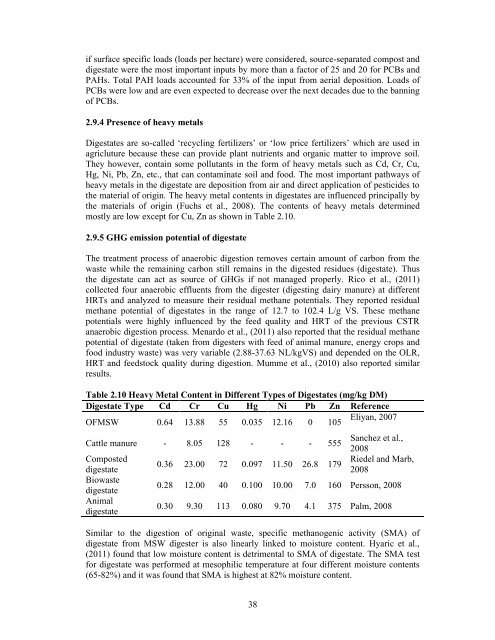dry anaerobic digestion of municipal solid waste and digestate ...
dry anaerobic digestion of municipal solid waste and digestate ...
dry anaerobic digestion of municipal solid waste and digestate ...
Create successful ePaper yourself
Turn your PDF publications into a flip-book with our unique Google optimized e-Paper software.
if surface specific loads (loads per hectare) were considered, source-separated compost <strong>and</strong><br />
<strong>digestate</strong> were the most important inputs by more than a factor <strong>of</strong> 25 <strong>and</strong> 20 for PCBs <strong>and</strong><br />
PAHs. Total PAH loads accounted for 33% <strong>of</strong> the input from aerial deposition. Loads <strong>of</strong><br />
PCBs were low <strong>and</strong> are even expected to decrease over the next decades due to the banning<br />
<strong>of</strong> PCBs.<br />
2.9.4 Presence <strong>of</strong> heavy metals<br />
Digestates are so-called ‘recycling fertilizers’ or ‘low price fertilizers’ which are used in<br />
agricluture because these can provide plant nutrients <strong>and</strong> organic matter to improve soil.<br />
They however, contain some pollutants in the form <strong>of</strong> heavy metals such as Cd, Cr, Cu,<br />
Hg, Ni, Pb, Zn, etc., that can contaminate soil <strong>and</strong> food. The most important pathways <strong>of</strong><br />
heavy metals in the <strong>digestate</strong> are deposition from air <strong>and</strong> direct application <strong>of</strong> pesticides to<br />
the material <strong>of</strong> origin. The heavy metal contents in <strong>digestate</strong>s are influenced principally by<br />
the materials <strong>of</strong> origin (Fuchs et al., 2008). The contents <strong>of</strong> heavy metals determined<br />
mostly are low except for Cu, Zn as shown in Table 2.10.<br />
2.9.5 GHG emission potential <strong>of</strong> <strong>digestate</strong><br />
The treatment process <strong>of</strong> <strong>anaerobic</strong> <strong>digestion</strong> removes certain amount <strong>of</strong> carbon from the<br />
<strong>waste</strong> while the remaining carbon still remains in the digested residues (<strong>digestate</strong>). Thus<br />
the <strong>digestate</strong> can act as source <strong>of</strong> GHGs if not managed properly. Rico et al., ( 2011)<br />
collected four <strong>anaerobic</strong> effluents from the digester (digesting dairy manure) at different<br />
HRTs <strong>and</strong> analyzed to measure their residual methane potentials. They reported residual<br />
methane potential <strong>of</strong> <strong>digestate</strong>s in the range <strong>of</strong> 12.7 to 102.4 L/g VS. These methane<br />
potentials were highly influenced by the feed quality <strong>and</strong> HRT <strong>of</strong> the previous CSTR<br />
<strong>anaerobic</strong> <strong>digestion</strong> process. Menardo et al., (2011) also reported that the residual methane<br />
potential <strong>of</strong> <strong>digestate</strong> (taken from digesters with feed <strong>of</strong> animal manure, energy crops <strong>and</strong><br />
food industry <strong>waste</strong>) was very variable (2.88-37.63 NL/kgVS) <strong>and</strong> depended on the OLR,<br />
HRT <strong>and</strong> feedstock quality during <strong>digestion</strong>. Mumme et al., (2010 ) also reported similar<br />
results.<br />
Table 2.10 Heavy Metal Content in Different Types <strong>of</strong> Digestates (mg/kg DM)<br />
Digestate Type Cd Cr Cu Hg Ni Pb Zn Reference<br />
OFMSW 0.64 13.88 55 0.035 12.16 0 105<br />
Eliyan, 2007<br />
Cattle manure - 8.05 128 - - - 555<br />
Composted<br />
<strong>digestate</strong><br />
Bio<strong>waste</strong><br />
<strong>digestate</strong><br />
Animal<br />
<strong>digestate</strong><br />
0.36 23.00 72 0.097 11.50 26.8 179<br />
38<br />
Sanchez et al.,<br />
2008<br />
Riedel <strong>and</strong> Marb,<br />
2008<br />
0.28 12.00 40 0.100 10.00 7.0 160 Persson, 2008<br />
0.30 9.30 113 0.080 9.70 4.1 375 Palm, 2008<br />
Similar to the <strong>digestion</strong> <strong>of</strong> original <strong>waste</strong>, specific methanogenic activity (SMA) <strong>of</strong><br />
<strong>digestate</strong> from MSW digester is also linearly linked to moisture content. Hyaric et al.,<br />
(2011) found that low moisture content is detrimental to SMA <strong>of</strong> <strong>digestate</strong>. The SMA test<br />
for <strong>digestate</strong> was performed at mesophilic temperature at four different moisture contents<br />
(65-82%) <strong>and</strong> it was found that SMA is highest at 82% moisture content.

















